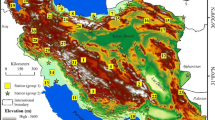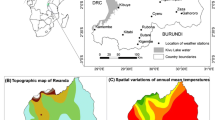Abstract
Lebanon, with its geographic location facing the Mediterranean Sea and dominant rugged topography, is characterized by a strong climatic variability even between zones located few kilometres apart. The investigation of the climatic indices is necessary to delineate such diverse climatic situation over Lebanon. In this context, this paper investigates the periodic behaviour in annual Emberger aridity index (AIE) of 14 weather stations in representative sites of Lebanon. The AIE indicates that the dominant climate of Lebanon, which is mainly varying from humid to semi-arid, follows cyclonic meteorological patterns. The periodicities of AIE identified by using a robust technique seem almost altitude related and range between 2 and 21 years. The geographic distribution of periodicities implies two major zones in the northern and southern parts of Lebanon, being featured by longer and shorter periodicities, respectively. The formation of these two periodicity zones can be related to regional climatic zoning. The remarkable diversity in periodicity indicates predominant microclimates with specified cyclonic climate that characterizes Lebanon’s climate rather than a merely existence of climate change.





Similar content being viewed by others
References
Agnew C, Anderson W (1992) Water in the arid realm. Routledge, London
Ahdesmäki M, Lähdesmäki H, Pearson R, Huttunen H, Yli-Harja O (2005) Robust detection of periodic time series measured from biological systems. BMC Bioinform 6:117
Arora VK (2002) The use of the aridity index to assess climate change effect on annual runoff. J Hydrol 265:164–177
Baltas E (2007) Spatial distribution of climatic indices in northern Greece. Meteorol Appl 14:69–78
Baltas E, Mimikou M (2005) Climate change impacts on the water supply of Thessaloniki. Int J Water Resour Dev 21:341–353
Beck TW, Housh TJ, Weir JP, Cramer JT, Vardaxis V, Johnson GO, Coburn JW, Malek MH, Mielke M (2006) An examination of the runs test, reverse arrangements test, and modified reverse arrangements test for assessing surface EMG signal stationarity. J Neurosci Methods 156:242–248
Benassi M (2008) Drought and climate change in Morocco. An analysis of precipitation field and water supply. In: López-Francos A (ed) Drought management: scientific and technological innovations. CIHEAM, Zaragoza, pp 83–86
Bendat JS, Piersol AG (1986) Random data: analysis and measurement procedures. 2nd ed. Wiley, New York
Bou Zeid E, El-Fadel M (2002) Climate change and water resources in Lebanon and the middle East. J. Water Resour Plan Manag 128:343–355
CAL (1971) Atlas climatique du Liban, Tome 1. Ministère des Travaux publics et Transports, Service Météorologique
CAL (1973) Atlas Climatique du Liban, Tome 1. Ministère des Travaux publics et Transports, Service Météorologique
CAL (1982) Atlas Climatique du Liban. Service Météorologique, Ministère des publics et Transports, Tome II
CAS 2015. Central Administration of Statistics. Bull. Environ. Agric. 0. des publics et Transports
De Martonne E (1925) Traité de Géographie Physique, Vol I: notions generales, climat, hydrographie. Geogr Rev 15:336–337
Deniz A, Toros H, Incecik S (2011) Spatial variations of climate indices in Turkey. Int J Climatol 3:394–403
DGAC (1999) Direction Générale de l’Aviation Civile, rapport annuel. Beyrouth, Liban
Emberger E., 1932. Sur une formule climatique et ses applications en botanique. La Météorologie, 423–432
Funk C, Peterson P, Landsfeld M, Pedreros D, Verdin J, Shukla S, Husak G, Rowland J, Harrison L, Hoell A, Michaelsen J (2015) The climate hazards infrared precipitation with stations—a new environmental record for monitoring extremes. Scientific Data 2:150066. https://doi.org/10.1038/sdata.2015.66
IPCC (2007) Climate change 2007: mitigation. Contribution of working group III to the fourth assessment report of the intergovernmental panel on climate change. Cambridge University Press, Cambridge
IPCC (2012) Glossary of terms. In: Field CB, Barros V, Stocker TF, Qin D, Dokken DJ, Ebi KL, Mastrandrea MD, Mach KJ, Plattner G-K, Allen SK, Tignor M, Midgley PM (eds) Managing the risks of extreme events and disasters to advance climate change adaptation: a special report of working groups I and II of the intergovernmental panel on climate change (IPCC). Cambridge University Press, Cambridge, pp 555–564
Karam F (2009) Climate change and variability in Lebanon: impact on land use and sustainable agriculture development. Unpublished report, available on: http://www.fao.org/sd/climagrimed/pdf/ws01_24.pdf
LARI (2017) Lebanese Agricultural Research Center. Climatic Data. Monthly Bull, Department of Irrigation and Agro-meteorology (DIAM)
Maliva R, Missimer T (2012) Arid lands water evaluation and management. Springer, Berlin
NC (2011) Lebanon’s second national communication to the UNFCCC. Ministry of Environment. GEF, UNDP
NOAA (2013) National oceanographic data center, Lebanon climatological data. Library. http://docs.lib.noaa.gov/rescue/data_rescue_lebanon.html
Perry AH (1988) Trends in maltese rainfall: causes and consequences. In: Gregory S (ed) Recent climatic change. Belhaven Press, London, pp 125–129
Priestley MB (1981) Spectral analysis and time series. Academic Press, London
Ramadan H, Beighley R, Ramamurthy A (2013) Temperature and precipitation trends in Lebanon’s largest river: the Litani Basin. J Water Resour Plan Manage 139:86–95
Shaban A (2009) Analyzing ASTER and Landsat 7 ETM+images to identify geomorphologic ring structures in Lebanon. Int J Remote Sens 30:1127–1140
Shaban A (2011) Analyzing climatic and hydrologic trends in Lebanon. J Environ Sci Eng 5:483–492
Shaban A (2014) Physical and Anthropogenic challenges of water resources in Lebanon. J Scientific Res Rep 3:164–179
Shaban A, Houhou R (2015) Drought or humidity oscillations? The case of coastal zone of Lebanon. J Hydrol 529:1768–1775
Siegel S, Castellan NJ Jr (1988) Nonparametric statistics for the behavioral sciences, 2nd edn. McGraw-Hill, New York, pp 58–72
Telesca L, Giocoli A, Lapenna V, Stabile TA (2015) Robust identification of periodic behavior in the time dynamics of short seismic series: the case of seismicity induced by Pertusillo Lake, southern Italy. Stoch Environ Res Risk Assess 29:1437–1446
Thornthwaite CW (1948) An approach toward a rational classification of climate. Geogr Rev 38:55–94
Wichert S, Fokianos K, Strimmer K (2004) Identifying periodically expressed transcripts in microarray time series data. Bioinformatics 20:5–20
Wright G (2003) Radial basis function interpolation: numerical and analytical developments. Ph.D. Dissertation. University of Colorado at Boulder, Boulder, CO. AAI3087597
Acknowledgements
This study was supported by the CNR-CNRSL Project 2017-2018.
Author information
Authors and Affiliations
Corresponding author
Ethics declarations
Conflict of interest
The authors declare that no conflict of interests exists.
Electronic supplementary material
Below is the link to the electronic supplementary material.
Appendix
Appendix
The map shown in Fig. 5 was obtained through the following steps:
-
1.
A shape file (vector data of points) was created using the coordinates of the station locations and including the periodicities as attributes;
-
2.
The radial basis function (RBF) (Wright 2003) was used for interpolating, due to its less error and more confidence in the results;
-
3.
After creating different interpolation grids (raster layers), they are classified into categories representing the periodicity of the aridity index;
-
4.
The classified grids are converted to polygons, and these polygons are refined (smoothed to be made contour like) using ArcGIS functions;
-
5.
Finally, additional manual editing is done to remove slivers and small polygons.
Rights and permissions
About this article
Cite this article
Telesca, L., Shaban, A. & Awad, M. Analysis of heterogeneity of aridity index periodicity over Lebanon. Acta Geophys. 67, 167–176 (2019). https://doi.org/10.1007/s11600-018-00243-5
Received:
Accepted:
Published:
Issue Date:
DOI: https://doi.org/10.1007/s11600-018-00243-5




